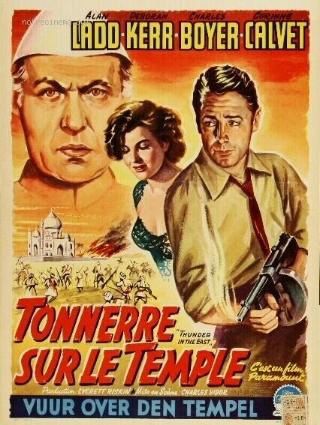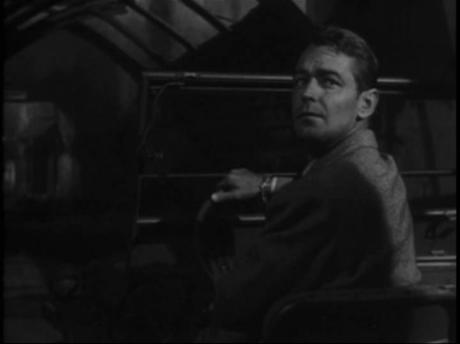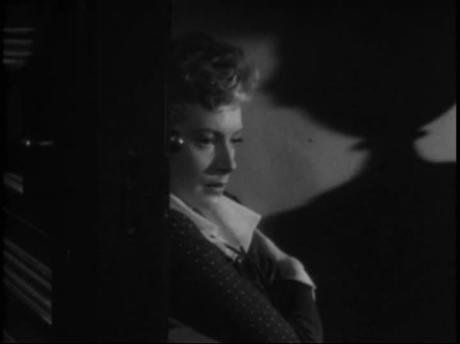
An exotic locale, a morally dubious lead, and a set of circumstances with all the potential of a powder keg in a raging inferno – this is the kind of scenario which generally grabs my attention effortlessly. Such movies always hold out the promise of adventure, intrigue and, if we’re lucky, maybe a little something extra to spice it all up. Thunder in the East (1951) is a film that could have sold itself to me on the basis of the cast alone, and the aforementioned plot elements simply ramped up the appeal.
India, in the period just after independence, and a plane lands in the fictional province of Ghandahar. The pilot is Steve Gibbs (Alan Ladd), one of those rootless Americans so beloved of films of the period. He claims to have an appointment with the Maharajah, and positively exudes the kind of cockiness that is the preserve of men confident of making a quick and substantial profit. We never learn much about what made Gibbs the man he is beyond the fact he once was a member of the Flying Tigers, but that’s not really important. He’s in Ghandahar to sell a shipment of arms to the head man and the unstable political situation thereabouts leaves him feeling pretty sure of his chances of success. Regardless of all that, our man is riding for a fall as he’s failed to count on the presence of the Maharajah’s right hand man, and the real power in the province, Singh (Charles Boyer). The latter is a man of rigid principle, one who has seen what can be achieved without resort to violence and is thus determined to be rid of Gibbs and his cargo of munitions. Before he knows what’s hit him, this flyer finds his wings clipped and his weapons impounded. Still and all, a man like Gibbs is naturally inclined to sniff out the chance of making a deal wherever and whenever the opportunity arises. If that means selling his wares to the rebel opposition in the surrounding hills and later topping up his take by evacuating the Europeans he’s placed in greater danger, then so be it. But fate, or perhaps destiny if one’s mind runs in that direction, has a habit of intervening and toying with such schemes. Few men are truly devoid of conscience or feelings, and the apparently innocuous presence of a blind woman (Deborah Kerr) stirs memories of such sentiments within Gibbs. What remains to be seen is how this mercenary character will respond, and indeed how others will similarly address their own preconceptions, as the militia relentlessly burns and butchers its way towards the practically defenseless palace.

Thunder in the East was directed by Charles Vidor, a man whose work I’m not all that familiar with. Gilda is clearly his standout title (Ladies in Retirement is one I intend to get round to as I work my way through my unwatched pile) and ought to mark him out for attention even if he’d never shot another picture. His work on here is fine although it flags a little in the middle as the tension drops off slightly. The film was photographed by Lee Garmes, who was in the middle of a fine run at this point, and his touch is particularly evident in the second half. While it never reaches the heights of exoticism or atmosphere to be found in von Sternberg’s Shanghai Express there’s much to admire in the filming of Ladd’s drive through the sacked town and the tense climax in the besieged palace grounds.
For me, the theme underpinning a film is the aspect which stimulates or interests me most. Even the most casual viewer to this site will be aware that I’m an unashamed fan and champion of the western, that purest and most beautiful of all cinematic genres. The classic western theme is that of redemption and spiritual rebirth, yet it’s by no means confined to that genre and can be found throughout cinema, particularly in the classic period. Thunder in the East is therefore no exception in this respect, and I think it’s this which is its greatest strength. The intrigue and suspense have a part to play of course but the heart of it all, that which gives it life and artistic value, is the redemptive journey undertaken by Steve Gibbs. Allied to this, and bolstering it all, is the focus on the restorative power wrought by the faith of others in the inherent decency and humanity of even the most jaded of souls; just as Ladd becomes the eyes of Kerr by proxy, so she becomes the small voice whispering persuasively within his mind to kindle the embers of half-recalled ideals.

Alan Ladd seemed to make a habit of starring in a string of movies located in the East around this time – Calcutta, Saigon, China – and this provided a pretty good role for him. He had the laconic toughness down pat and was generally at his best when he used that quality to disguise his inner pain. I think the best acting always derives from the search, either within or without, for fulfillment and the peace which accompanies it, and Ladd was a fine exponent of that. For such a quest to take place it’s necessary for a tangible and credible motive to exist. If Ladd is the tarnished knight, then his grail is represented by Deborah Kerr. She was always a classy performer, alluring yet also pure. I alluded to the western above, and I shall do so again as Kerr’s role illustrates just how significant the female frequently is in both spurring and completing the spiritual odyssey of the hero. Playing blind, or indeed any physically challenged, characters can be problematic, the potential for descent into cliché being ever present. In my opinion Kerr avoids that danger and gives a portrayal of a fully rounded character who never strays towards the pitiful nor the superhuman. Boyer is also fine as the conflicted and idealistic Singh, embarking on a philosophical journey of his own over the course of the story. In support, Corinne Calvet is perhaps somewhat wasted as the fearful courtesan and I think more could have been made of her part. In smaller roles, John Williams and Cecil Kellaway are welcome faces in fairly typical, but highly enjoyable, character turns.
As a fan of Alan Ladd I’ve always been on the lookout for his films and Thunder in the East has been one of the more elusive titles. It’s recently been released on DVD in Italy and I was keen to sample it. The transfer is what I’d term as OK, a little soft and muddy with occasional instances of print damage visible. Having said that, this Paramount film is not widely available and I can’t say the overall presentation was a major disappointment under the circumstances. The soundtrack is offered in both the original English and also an Italian dub and there are optional Italian subtitles. The disc features the theatrical trailer and a selection of galleries as extras. I should perhaps point out that the movie offers up a critique of the philosophy of passive resistance, building towards a resolution that may or may not appeal – I leave that judgment to each individual, and it’s not my intention to pass comment on it either way. On the whole, I liked the film. Some may regard the ending as being a little rushed but I can’t say it bothered me too much. Recommended to those who enjoy Ladd and Kerr, and who appreciate the kind of themes often found in westerns of the era.
